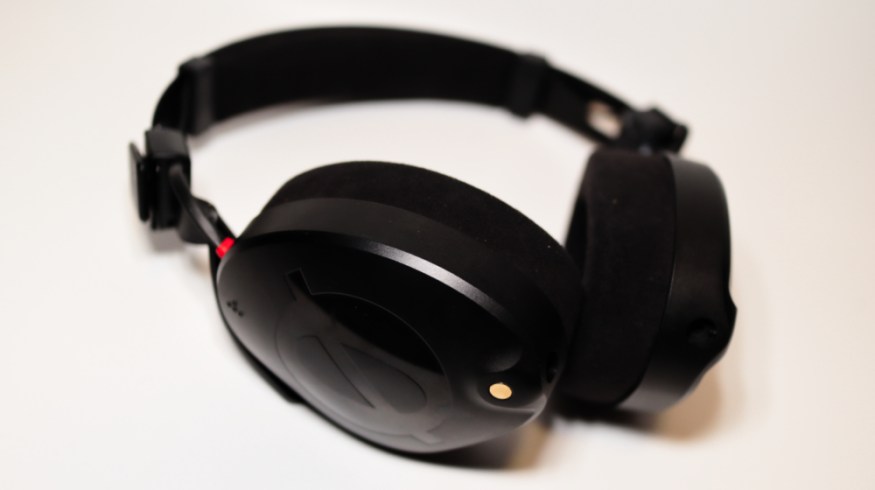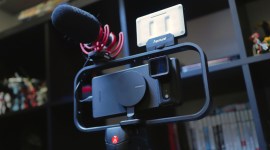
Rode NTH-100 Review: Great Looks But Faulty Design
The NTH-100 from Rode is an eye-catching headset with above-average sound, but it broke after four months. Here are the final pros and cons.
Rode makes headphones now? That’s what I asked myself when the NTH-100 headphones were first announced.
I wasn’t expecting Rode to release headphones, but it made sense that a company that makes microphones would also make headphones to monitor audio. At first glance, the headphones looked sleek and modern, and it was promising that Rode made them because they’re known for producing high-quality gear.
But I wondered if these headphones could compete with the best pair of monitors in this price category, or any sort: Audio-Technica’s ATH-M50x. The NTH-100 and M50x retail for $150, though you can find the M50x for around $120.
I got the NTH-100 headphones in April—they were provided to me for review by Rode—and I’ve been testing them for the last six months. The reason for the lengthy review period is that I wanted to find out how they stacked up against my 5-year-old M50x headphones, which have never let me down.
The extra time revealed much about the NTH-100s that I wouldn’t have realized in just one or two weeks of testing. During that time, I found a lot to like. But, I also found some dealbreakers that are hard to look over, especially when Audio-Technica’s M50x headphones are available for the same price and are, in my opinion, one of the best all-around headphones.
The sound is okay but not the best
Before I get into what I liked and didn’t like about this headset, let’s talk about what this headset sounds like. That’s probably why you’re here, anyway. I don’t have any significant complaints about sound quality.
The NTH-100 are monitor headphones, which means they’re supposed to have a neutral sound for editing audio. In my testing, I found that to be true. They performed as well as expected when editing video. With some EQ tuning via FXSound, I also enjoyed using the headphones to listen to music while writing, especially music with more bass.
While not portable, the NTH-100 headset is versatile thanks to its low impedance of 32 ohms. This makes it possible to plug in the headset to any device without an amplifier.
For context, headphones with an impedance above 32 ohms should be hooked up to a DAC, audio interface, or amplifier to bring up sound levels to normal. Without those aids, higher-impedance headphones will sound extremely quiet and will not perform as expected.
But because the NTH-100 headset has an impedance that sits right on the threshold, it’s unnecessary to use an amplifier. I appreciate Rode for doing that. It makes it easier to listen to music on my phone or gaming console.
The NTH-100 also has better noise isolation because of the thicker earcup cushions, which are filled with memory foam and cooling gel. But despite all the pros and reportedly better specs, such as having more significant drivers, a more extensive frequency range, and higher sensitivity than the M50x, I still prefer Audio-Technica’s headset.

In back-to-back comparisons with the M50x, I noticed Rode’s NTH-100 headset was slightly more bassy, which led to vocals sounding a bit muddy. I also noticed that the NTH-100s were quieter than the M50x when listening at the same volume. This is weird, considering Rode’s headset is listed as being more sensitive—110dB compared to the M50x’s 99dB.
The M50x has an even, more neutral sound. They sound great across the board, whether you’re editing audio or listening to podcasts. The M50x headset is reliable and delivers a consistent sound, even after half a decade of use.
According to some online, the NTH-100 has balance issues, with one side of the headset sounding different. Although I didn’t encounter that problem, it’s worrisome if you’re professional planning to use this headset on paid projects.
What Rode Did Right
Rode’s NTH-100 first caught my eye because it looks very different from other monitor headphones. Most monitor headphones come primarily in black. The NTH-100, however, has aesthetic touches that make it stand out, such as the black-on-black Rode logo and the brass circles on the earcups.
Included with the headset are various plastic rings that come in bold colors. These fit over the headphone jack and bring a pop of color that is striking against the all-black headset. Apart from the aesthetics, the headset is hefty and feels more durable than all-plastic headsets, thanks to the prominent use of metal.
Although NTH-100s weren’t perfect, I can see that Rode put a lot of effort into making a captivating headset. And I do appreciate the NTH-100 for introducing me to features and design touches I’d like to see on other monitor headphones in the future.
Pillowy Earcups
When you’re wearing a pair of headphones for hours at a time, as editors do, comfort is a priority. Rode delivers on that via the earcup and headband cushions. The cushions are made with thick memory foam, creating a comfortable fit that never wears out its welcome.
Inside the cups is a layer of cooling gel that feels cool to the touch every time you put the headphones on. While they don’t still cool forever, it does help reduce sweating, which happens when you’re wearing rubber or leather cups.
The headband is also made of the same material. In my testing, the earcups and headband remain in excellent condition. However, I can’t say the material will hold up after years of use.
In comparison, the pleather cups on the M50x are infamous for needing replacment after a few years, something I recently did. Besides breaking down, the cups on the M50x are not breathable and are relatively thin, causing sound leakage that’s noticeable at louder volumes. The cups are also partly at fault for the M50x’s terrible isolation. However, that’s not a problem that NTH-100 headphones suffer from.
The Rode NTH-100 headset has better sound isolation thanks to the thicker foam earcup cushions. They create a tighter seal that helps to block out noise and prevent sound from leaking. Coworkers and roommates will appreciate it. That doesn’t mean these are noise-canceling headphones, but it’s an improvement on the M50x’s thin earcup cushions.
Packed with Convenient Features
The NTH-100 has an audio port on either side. When using the headphones at my desk, I use the correct port because that’s the side nearest to my audio interface. But, when I’m listening to music via my stereo receiver, I plug the cable on the left side.
Having the option to pick which side prevents the cable from getting in the way or brushing up against your lap when you move, which is very annoying. Though this is a minor feature, it’s made it hard to go back to headphones with only a single audio port, such as the M50x. It’s gotten so bad I’ve considered picking up the Bluetooth version of the headphones. That’s how great this feature is.

The height adjustment is another thing I like about the NTH-100. Instead of using a simple sliding mechanism to adjust your preferred height, the NTH-100 uses a twisting lock that holds the earcup in place. Unlocking the earcup allows it to move freely up and down the metal rail. If you’re constantly trying to find the sweet spot fit on your headphones, the lock makes this a non-issue as long you don’t mess with it.
The earcups also have good mobility. The clasp that attaches the metal earcup arm to the rail has the slightest gap. This allows the earcup to swivel slightly on the x-axis for a more comfortable fit. Additionally, the hinge on the arm, where it connects to the earcup, allows it to rotate significantly on the z-axis.

Waiting for the NTH-200
Overall, the above features don’t make the NTH-100 a must-have headset. Still, I acknowledge that Rode tried to do something different and got some things right. When entering such a saturated market, many companies will make a slightly better version of the same product. But as much as I did enjoy a few of the NTH-100 features, the overall experience was frustrating.
Not Made to Last
I mentioned earlier how the heft of this headset gives off a feeling that it’s durable. The use of metal for the headband and earcup arm certainly does a lot to promote that idea. The headphones feel sturdy, unlike the M50x, which has a plastic build that feels flimsy in comparison.
But the M50x headset has never failed me in the 5+ years I’ve owned them. Unfortunately, I can’t say the same about the NTH-100: The left earcup fell off within four months.

While the headband and earcup arm are made from metal. However, the clasp that connects the two is not, and that’s where the fault lies. After a few months of use, the plastic clasp snapped one day as I put the headset on.
The constant swivel of the earcup arm within the clasp and the occasional holding of the headset via a single earcup probably exacerbated the problem. But that’s no different from how I treat other headsets. The only explanation for this is the plastic is too thin and brittle to support the weight of the cup long-term.
It’s a fatal design flaw that could have been easily avoided if Rode had used a more robust material, like metal, for the clasp. The headband and arm are made of metal, so I don’t understand why the clasp isn’t.
While I was able to fix it with superglue, it’s nevertheless a dealbreaker. And with the right clasp beginning to crack, there’s no excusing the broken clasp as faulty.
What’s worse is that this isn’t an isolated incident. Several commenters on this Reddit thread have confirmed the same thing happened to their NTH-100 headsets.
Smaller Complaints
The metal construction is one of the better things about this headset, but I think it’s also its downfall in two key ways. For one, the headband on the headset can get uncomfortable after 4 to 6 hours.
I know it’s a long time to wear a headset, and most people won’t wear the NTH-100 for that long, but it matters if you’re editing all day.
Every time I wore the NTH-100 all day, I could feel the headset digging in, which made the top of my head feel sore. Though comfortable initially, the cushion is not enough to counteract the weight of the headset pressing down on you. It’s the weight of the headset, not the cushion, that’s the problem.
My M50x headphones are much lighter and have never caused me discomfort like that, even after wearing them for 8 hours.

Another issue I have is that the NTH-100s are not compact. You can move the earcups to the top to make them smaller, but you can’t fold them like other headsets. Instead, Rode provides a drawstring pouch for carrying the headphones.
The M50x headset, for example, can fold in, which fits nicely inside a hard carry case. However, it doesn’t make it any easier to take the headphones with you from home to work or vice versa. Rode could include a better case for transportation or, at least, sell one since it seems third parties are not interested in doing so.
Lastly, the headset comes with a single cable, which felt stingy. Usually I wouldn’t raise a stink, but the cables are expensive, and you have to buy the official NTH cables because they have a proprietary design.
The headphone end of the cable locks into the audio port by twisting it, preventing the cable from yanking out accidentally. That’s a nice feature, but the cables cost $22 for the 1.2m version; $25 for the longer 2.4m cable. That’s more than twice the price of similar-sized, standard audio cables on Amazon.
To be fair, the M50x also uses proprietary cables with a similar locking design. Still, Audio-Technica includes three cables of varying sizes: a 1.2m cable, a longer, 3m cable, and a 1.2m coiled cable that stretches up to 3m. You can also buy third-party cables on Amazon that are compatible with the M50x, which are much more affordable than the official cables.

If there’s an upside to the high cost of these audio cables, they come in several fun colors: pink, green, orange, and blue. The colored rings that fit over the headphone jack are included with the headset and are another way to set your headset apart.
The colored cables, or rings, are not necessary, but the orange and green cables Rode sent stick out among the mass of black cables on my desk. Color coding is also helpful if you own multiple headsets or work with others with the same headset.
But, really, I just like the colors. Not every piece of professional gear has to be black or gunmetal gray. It’s not like it’s illegal to make or own high-quality, professional equipment that’s also fun.
Good, not Great
Like they say in the house flipping industry, the NTH-100 has “good bones.” It’s a great blueprint from which Rode can make a proper sequel. Features like the extremely comfortable earcup cushions, the audio ports on either cup, and the locking height adjustment are great examples of comfort and convenience.
The features aren’t enough to make me ditch the M50x, but I’ve been spoiled. It’s been a wake-up going back to the M50x. Hopefully, the arrival of the NTH-100 will push Audio-Technica to finally update the M50x, which they last redesigned in 2014.
With a storied history in the audio space, Rode is the company that gets more right than wrong. In this case, however, it’s the latter. That doesn’t mean it’s a lousy headset; it’s just not as good as the ATH-M50, which has been, and still is, the standard for monitor headphones in this price range.
While the modern design and updated features of the NTH-100 make me hopeful for the future of this product line, there’s just not enough to recommend this headset over the M50x.




